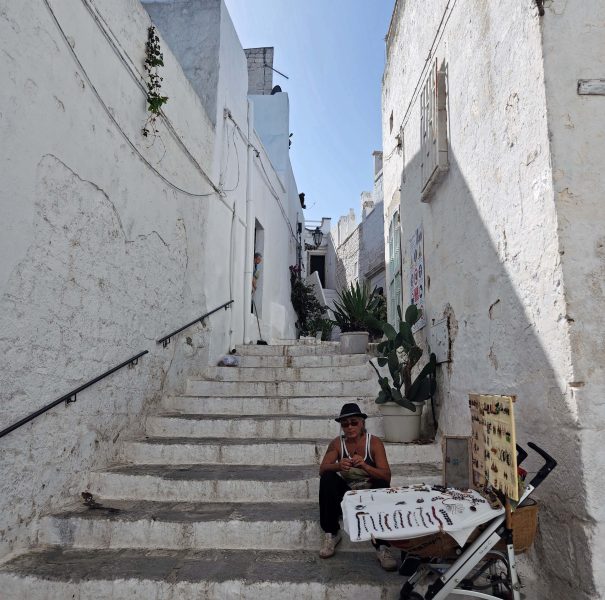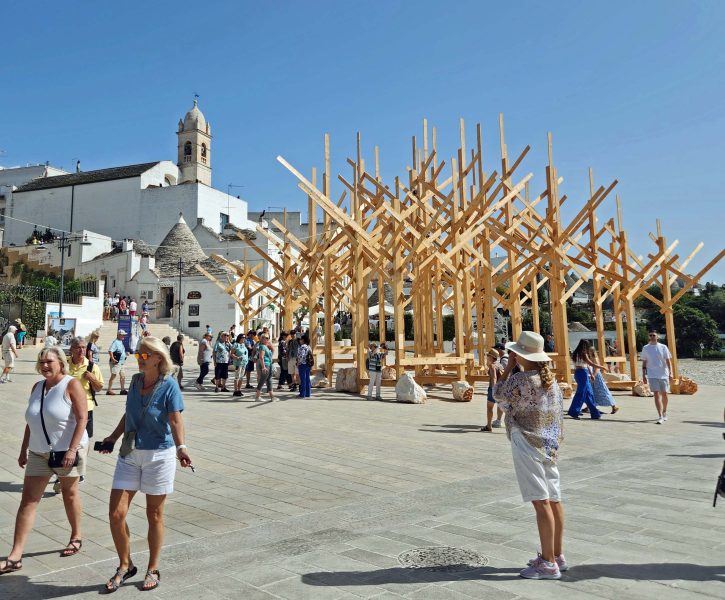Several location names were used when Ted and I took a shore excursion to see “Puglia’s White Cities”: Puglia, Ostuni, and Alberobello. They all sound equally Italian to me, but I’m pretty sure I’m correct when I say, in American terms, that Alberobello is a suburb bordering Ostuni in the district (state) of Puglia in southern Italy on the Adriatic Sea, and that Bari (where our ship docked) is the capital city of Puglia, similar to a state capital in the U.S.
At our ship’s dock, Ted and I saw this installation, and we decided that it represents the trulli (‘troo-lee) houses of Alberobello, the focus of our upcoming excursion.

As for seeing “Puglia’s White Cities,” our best overview was this one from our bus.

Most of our time was spent within the cities, so we couldn’t see beyond what you normally see when you’re in a city. This was the single point we found that overlooked the Adriatic Sea and included some of the white city of Ostuni below us. A white city on a sunny day is very light and bright and cheerful.

The trulli houses are in Alberobello, but the downtown area where our bus dropped us off was Ostuni. Ostuni was described in our excursion literature as a “labyrinth of alleyways, staircases and arches” and that was absolutely true. In the photo below, Ted and I are standing at the bottom of a hill in Ostuni, preparing to climb to Alberobello at the top where there are over one thousand trullo (the plural of trulli) waiting for us to see them. We didn’t see every one of the thousand trullo, but we walked around and saw a lot of them.
Our delicious group lunch was held at a restaurant about halfway up this hill. It’s on the right side of the street between the second and third flower pots, and there’s a table sitting on the street. It was a tiny little restaurant with tiny little rooms (and two tiny single-person bathrooms), yet, with practiced efficiency, the staff managed to serve 150 tourists from four buses a full four-course hot meal.

Trulli is the name of a building style that uses a dry stone structure—in other words, stones without mortar. The cone of the roof is built with two layers. The inner limestone layer is capped with a keystone and the second, outer layer ensures that the roof is watertight. The side walls are roughly three feet thick to keep the houses cool in the summer and warm in the winter.
It is believed that, during the 14th century, property taxes were very high in this area. To avoid those taxes, the feudal lords housed their farm workers in trulli structures. When the tax inspectors came to the area, the keystone was removed and the structure became a pile of stones with no resemblance to a residence that could be taxed. When the inspectors left, the trullo were rebuilt.
These fairy tale-like conical, white-washed structures are still inhabited today. I couldn’t find any definitive answer to whether or not they continue to be exempt from property taxes.

Here are some close-ups of how the stones are piled without mortar. There are more stones than dirt in this area—the main reason why tourism, rather than agriculture, provides 20 percent of the country’s income.


Trulli houses might have more than one large cone as well as several smaller ones, and individual cones might also have a second story, accessible by stairs or a ladder, depending on the size of the first-floor room. Even so, it’s a mystery to me why there are two ladders suspended between roofs in the photo below. It doesn’t seem likely they would take anyone to the first or second floors of the houses.
“Party lights” were strung between many houses—possibly serving as gentle streetlights at night? Naturally, the trullo are UNESCO protected, so maybe the party lights are a concession to safety without the culture clash of modern streetlights.

Trullo are often decorated with symbols, usually with a religious or astrological meaning. The symbols are not original to the houses, but were painted on them at a later time.

This was the prettiest group of trullo Ted and I saw. The whitewashed buildings, the blue sky, and the bright petunias are perfect together! Look closely and you’ll see a resident talking on her cell phone behind the back pot of petunias on the right—proof that these homes are inhabited.

After visiting the trullo neighborhood and fortifying ourselves with lunch, our guide walked us up a high, steep hill to see the 15th century Ostuni Cathedral. The church is located in a small square at the top of the hill and dates back to the year 1000, but was destroyed in a 1456 earthquake. The reconstruction of the cathedral included the large rose window visible in the photo below. The cathedral’s library has an archive of over 200 documents dating back to the 12th century. The artwork on the cathedral ceiling and interior walls is described as “remarkable,” but we were not able to enter the cathedral.

Our guide gave us pertinent information about the cathedral and then left us to spend some free time on our own exploring Ostuni. Before going down the hill, Ted and I walked around this small, historic square for a little while. The Arco Scoppa (the darker, arched portion of the picture, is an elevated passage between the bishop’s palace the seminary. It faces the cathedral and, along with the cathedral, is one of the main landmarks of the town. It’s not a bird, a plane, or even Superman–all those people looking upward are admiring the rose window in the cathedral across from the Arco Scoppa.

Later, Ted and I walked down this pretty street.

We greeted this vendor, sitting on a stairway that led to several apartments. Maybe he lives in one of them and works close to home. At the top of the first flight of stairs, there’s a woman sweeping her doorway—his wife?

Not surprisingly, we saw another mini café. The indoor restaurant was small, but had more seating than the two four-tops outside.

Treedom is an organization that directly finances small agroforestry projects in various countries. The city of Alberobello invited Treedom to create an installation to be placed in the main city square for its Light Festival in 2023. The result is shown below. It is supposed to invoke the image of a geometrical forest of trees, with rocks to add a natural touch. The rocks also have a role in balancing the installation and stabilizing the pole bases. Benches and bar counters are part of the structure and contribute to its stability by connecting the poles. Would “unusual” be an apt description of this installation?

Ted and I had some extra time before it was time to board our bus and head back to Bari and our ship, so we stopped for some ice cream at a café with one of those outdoor European mascots that indicate ice cream shops. The ice cream was good and, when we finished eating it, we used the restroom before our ride back to the ship.
The restroom wasn’t as good as the ice cream. The toilet worked, but there was no toilet paper. (Luckily, when we were in Egypt, Hanan told us to always carry some toilet paper.) There was soap, but the sink faucet failed to produce water and there was nothing to dry our hands. I guess hands don’t need to be dried if there’s no water. To deal with the situation, we soaped up our hands, rinsed them with water from our water bottles, flapped them in the air to dry, and called them clean. We’ve been in worse restrooms, and this one didn’t come close to those we used in Lombok. Chalk it up to another travel adventure and another story to tell.
